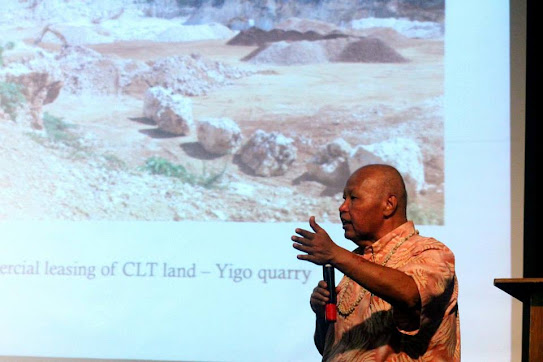Manteni i Tano ya Ta Susteni i Taotao
More than a decade ago, a statue was unveiled in Hagåtña for the late Angel L.G. Santos in the park which bears his name in memoriam.
It has been more than two decades since the passing of this iconic Chamoru figure. It has always intrigued me the way Santos morphed in meaning locally – from a patriotic, military-serving young Chamoru, to a loincloth-wearing taimamahlao chattaotao activist, to politician and defender of human rights, to visage on stickers, T-shirts and symbol of Chamoru strength and pride. Angel Santos and Nasion Chamoru worked hard, in particular in the 1990s, to push to the forefront of the island’s consciousness issues such as Chamoru rights, especially around political status and land.
One of their biggest successes is not the sinahi-necklace-wearing that has become so commonplace, but rather their protest efforts in getting the Chamorro Land Trust implemented and formalized.
Debates over the changing of the rules last year for the Chamorro Land Trust Commission and recent public outcry over the leasing of CLTC lands to commercial interests makes me feel like a reminder over the roots of this commission and its purpose might be necessary.
The Chamorro Land Trust was not created by Angel Santos and Nasion Chamoru, and this is an important point, because it helps us understand that the raising of consciousness around this issue is not something that started in the 1990s, but extends back further. Nasion Chamoru effectively built off of movements started decades before and were able to tap into certain longtime frustrations held by the Chamorus of Guam, which people often felt they could not express.
As Robert Underwood, a key figure in those consciousness-raising movements has noted, land – the U.S. military’s taking of it after World War II – is the one issue that seemed to be able to transform an otherwise patriotic and American-loving Chamoru nurse, teacher, soldier into an angry activist.
The displacement that Chamorus experienced is something that still seethes and burns in certain families or certain communities. It helped to intensify the societal changes that took place after the war, as so many families didn’t have access to viable lands in order to sustain themselves.
As Guam became more and more developed, modernized or Americanized (hagu la’mon put hafa I mas propiu na palabra), certain Chamoru leaders say there is potential for the indigenous people of Guam to be further displaced similar to the state of Native Hawaiians or Native Americans.
Despite the Chamorro Land Trust being public law since 1974, it was not implemented for more than 20 years.
Reasons for this lack of action have ranged from different administrations abusing the land meant to be held in trust for the Chamoru people and also fears that providing land in this way might be “unconstitutional.”
Angel Santos and Nasion Chamoru took up the Chamorro Land Trust as an issue of protest in the 1990s.
The path to finally implement it was not easy and required battles on multiple fronts. All and all, it required court cases, hunger strikes, protests as well as two very public campouts in the front field of Adelup, each lasting more than a month.
Angel Santos and Nasion Chamoru accomplished many things in their heyday, but their involvement in getting the Chamorro Land Trust implemented is one of their crowning achievements.
The late Sen. Ben Pangelinan once said, "anggen ta manteni i tano', ta susteni i taotao." If we hold on to the land, we sustain the people.
The Chamorro Land Trust was a government program born from a very different idea than most government agencies.
It was conceived, forged and given structure through different stages of Chamoru dreams and fears for their future.
It shares its legacy with so many great thinkers and fighters (in different ways) for indigenous rights.
It was born from the idea that, even if things around us change on this island, we should still find ways to keep a feeling of continuity, a strong sovereign sense of who we are.
The land, i tano’-ta, keeping part of it in trust was important in giving that idea life.




Comments